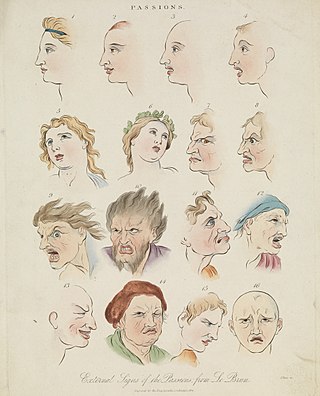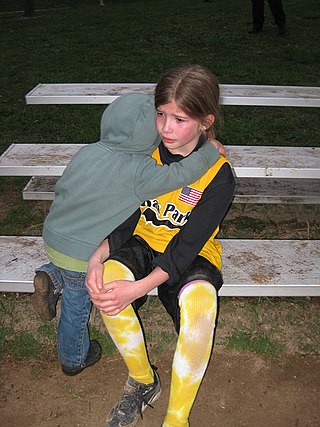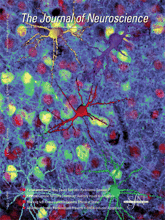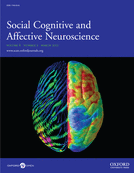
Emotions are mental states brought on by neurophysiological changes, variously associated with thoughts, feelings, behavioral responses, and a degree of pleasure or displeasure. There is currently no scientific consensus on a definition. Emotions are often intertwined with mood, temperament, personality, disposition, or creativity.

Empathy is the capacity to understand or feel what another person is experiencing from within their frame of reference, that is, the capacity to place oneself in another's position. Definitions of empathy encompass a broad range of social, cognitive, and emotional processes primarily concerned with understanding others. Types of empathy include cognitive empathy, emotional empathy, somatic empathy, and spiritual empathy.

Social cognition is a topic within psychology that focuses on how people process, store, and apply information about other people and social situations. It focuses on the role that cognitive processes play in social interactions.

Affective science is the scientific study of emotion or affect. This includes the study of emotion elicitation, emotional experience and the recognition of emotions in others. Of particular relevance are the nature of feeling, mood, emotionally-driven behaviour, decision-making, attention and self-regulation, as well as the underlying physiology and neuroscience of the emotions.
Social neuroscience is an interdisciplinary field devoted to understanding the relationship between social experiences and biological systems. Humans are fundamentally a social species, rather than solitary. As such, Homo sapiens create emergent organizations beyond the individual—structures that range from dyads, families, and groups to cities, civilizations, and cultures. In this regard, studies indicate that various social influences, including life events, poverty, unemployment and loneliness can influence health related biomarkers. The term "social neuroscience" can be traced to a publication entitled "Social Neuroscience Bulletin" which was published quarterly between 1988 and 1994. The term was subsequently popularized in an article by John Cacioppo and Gary Berntson, published in the American Psychologist in 1992. Cacioppo and Berntson are considered as the legitimate fathers of social neuroscience. Still a young field, social neuroscience is closely related to affective neuroscience and cognitive neuroscience, focusing on how the brain mediates social interactions. The biological underpinnings of social cognition are investigated in social cognitive neuroscience.

The Journal of Cognitive Neuroscience is a monthly peer-reviewed academic journal covering cognitive neuroscience. It aims for a cross-discipline approach, covering research in neuroscience, neuropsychology, cognitive psychology, neurobiology, linguistics, computer science, and philosophy. The journal is published by the MIT Press and the Cognitive Neuroscience Institute and the editor-in-chief is Bradley R. Postle.

The Journal of Neuroscience is a weekly peer-reviewed scientific journal published by the Society for Neuroscience. It covers empirical research on all aspects of neuroscience. Its editor-in-chief is Marina Picciotto. According to the Journal Citation Reports, the journal has a 2020 impact factor of 6.167.

John Terrence Cacioppo was the Tiffany and Margaret Blake Distinguished Service Professor at the University of Chicago. He founded the University of Chicago Center for Cognitive and Social Neuroscience and was the director of the Arete Initiative of the Office of the Vice President for Research and National Laboratories at the University of Chicago. He co-founded the field of social neuroscience and was member of the department of psychology, department of psychiatry and behavioral neuroscience, and the college until his death in March 2018.

Gary Berntson is an emeritus professor at Ohio State University with appointments in the departments of psychology, psychiatry and pediatrics. He is an expert in psychophysiology, neuroscience, biological psychology, and with his colleague John Cacioppo, a founding father of social neuroscience. His research attempts to elucidate the functional organization of brain mechanisms underlying behavioral and affective processes, with a special emphasis on social cognition.
Philosophical Psychology is a peer-reviewed academic journal devoted to the links between philosophy and psychology.
Brain and Cognition is an American scientific journal founded in 1982. It covers the fields of cognitive neuroscience and psychophysiology.
Cultural neuroscience is a field of research that focuses on the interrelation between a human's cultural environment and neurobiological systems. The field particularly incorporates ideas and perspectives from related domains like anthropology, psychology, and cognitive neuroscience to study sociocultural influences on human behaviors. Such impacts on behavior are often measured using various neuroimaging methods, through which cross-cultural variability in neural activity can be examined.
Educational neuroscience is an emerging scientific field that brings together researchers in cognitive neuroscience, developmental cognitive neuroscience, educational psychology, educational technology, education theory and other related disciplines to explore the interactions between biological processes and education. Researchers in educational neuroscience investigate the neural mechanisms of reading, numerical cognition, attention and their attendant difficulties including dyslexia, dyscalculia and ADHD as they relate to education. Researchers in this area may link basic findings in cognitive neuroscience with educational technology to help in curriculum implementation for mathematics education and reading education. The aim of educational neuroscience is to generate basic and applied research that will provide a new transdisciplinary account of learning and teaching, which is capable of informing education. A major goal of educational neuroscience is to bridge the gap between the two fields through a direct dialogue between researchers and educators, avoiding the "middlemen of the brain-based learning industry". These middlemen have a vested commercial interest in the selling of "neuromyths" and their supposed remedies.

The Journal of Memory and Language is a peer-reviewed interdisciplinary academic journal of cognitive science, which focuses primarily on the issues of memory and language comprehension. It has been published by Elsevier since 1985. The current editor-in-chief is Kathleen Rastle.

The Neuroscientist is a peer-reviewed academic journal that publishes papers in the field of Neurology and Neuroscience. The journal's editor is Stephen G Waxman. It has been in publication since 1995 and is currently published by SAGE Publications.

Matthew Dylan Lieberman is a Professor and Social Cognitive Neuroscience Lab Director at UCLA Department of Psychology, Psychiatry and Biobehavioral Sciences.
David Amodio is an American scientist who examines the psychological and neural mechanisms underlying social behavior, with a focus on self-regulation and intergroup relations. Amodio is known for his role in developing the field of social neuroscience and for his neuroscientific approach to social psychology.
Cognitive Computation is an international, peer-reviewed scientific journal, interdisciplinary journal that publishes articles describing original basic and applied work involving bio-inspired computational accounts of all aspects of natural and artificial cognitive systems. The journal is published by Springer Science+Business Media.

Cognitive, Affective, & Behavioral Neuroscience is peer-reviewed scientific journal covering research on behavior and brain processes in humans. It was established in 1973 as Psychobiology and received its current title in 2001, with volume numbering restarting at 1. The journal is published by Springer Science+Business Media on behalf of the Psychonomic Society and the editor-in-chief is Diego A. Pizzagalli.
Social cognitive neuroscience is the scientific study of the biological processes underpinning social cognition. Specifically, it uses the tools of neuroscience to study "the mental mechanisms that create, frame, regulate, and respond to our experience of the social world". Social cognitive neuroscience uses the epistemological foundations of cognitive neuroscience, and is closely related to social neuroscience. Social cognitive neuroscience employs human neuroimaging, typically using functional magnetic resonance imaging (fMRI). Human brain stimulation techniques such as transcranial magnetic stimulation and transcranial direct-current stimulation are also used. In nonhuman animals, direct electrophysiological recordings and electrical stimulation of single cells and neuronal populations are utilized for investigating lower-level social cognitive processes.











